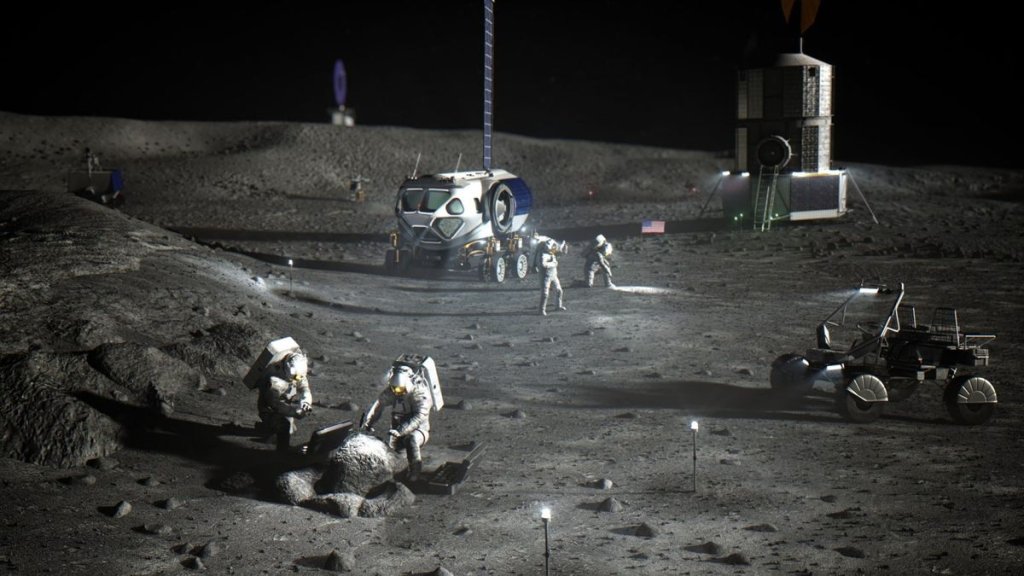Lockheed Martin has shared its vision for humanity’s future in space, as global space agencies aim for the moon and beyond.
Lockheed Martin, a key player in space exploration for decades, recently published a novella white paper called “A Vision for Humanity’s Future in Space.” The document outlines what the moon’s infrastructure may look like in the next few decades, including a bustling Artemis Base Camp at the lunar south pole and a lunar gateway in orbit above the moon to support interplanetary missions to Mars.
“It is imperative that such a vision be sustainable — technically, politically and economically,” Lockheed Martin wrote. “According to this guiding principle, the best lunar architecture over the long term is one that is water-based, nuclear-enabled and commercially invested.”
The novella, set in the 2040s, kicks off with a day in the life of a “lunar contractor,” who has launched to the moon for a six-month mission, during which time lunar resources are harvested, produced stored and distributed. These resources are an essential part of the trade cycle that is the Earth-moon-Mars system, allowing spacecraft to travel from Earth to Mars, with the moon as its central hub.
Related: NASA unveils plan for Artemis ‘base camp’ on the moon beyond 2024
The envisioned Artemis Base Camp consists of inflatable habitats and workstations at the center of the community, with landing pads on the outskirts. A power grid has been established to store and connect power generated by different sources across the moon, ranging from nuclear fission reactors to solar farms, fuel cells and flow batteries. Given the abundance of water ice at the lunar poles, the moon has become a water-based economy, pioneered by the fictional logistics company Aquarius.
“The inner solar system runs on water. For drinking, radiation shielding, a universal solvent, a source of breathable life support gasses — water’s many uses make it the inner solar system’s resource of choice,” Lockheed Martin wrote. “And then there’s the most critical family of commodities: water-based propellants.”
Developing water-based propellants on the moon means that spacecraft can launch empty — and for lower cost — and refuel in lunar orbit using propellants produced from icy regolith. This requires sophisticated fluid management (which Aquarius has nailed down by the 2040s), not only to process the lunar resources but to store the extracted hydrogen and oxygen and to transfer the propellant from one vehicle to another.
The idea of a water-based lunar economy is centered around the benefits of low-cost space travel using reusable vehicles for scalability — “and the most critical part of reusability is refuelability,” Lockheed Martin wrote. Reducing non-payload mass and instead relying on orbital gas stations not only lowers the cost of spaceflight but also increases the longevity of spacecraft. Utilizing hydrogen-oxygen propellants made from water, which can be found just about everywhere in the inner solar system, helps the lunar economy become less Earth-dependent.
“The lunar south pole in the 2040s is a stunning vision of the human frontier in development,” Lockheed Martin wrote. “The moon is the perfect testing ground and resource hub to support humanity’s expansion into the solar system.”
By the 2040s, it is expected that the moon’s resources can be even more widely shared. The novella describes a “Martian gas station” in orbit above the Red Planet, at which interplanetary transit vehicles arrive from the moon every 26 months with water supplies that can be turned into propellants. This allows Martian landers to refuel between missions to and from the surface of the Red Planet, where a small permanent base is being built, according to Lockheed Martin’s vision.
Expanding this infrastructure to Mars relied on hydrogen-fueled nuclear thermal propulsion (NTP) vehicles, whose significant thrust shortens the travel time to Mars, requiring less resources and reducing crew exposure to harmful radiation.
The construction and maintenance of both a lunar and Martian base is largely supported by robotic assistants, overseen by lunar contractors. However, the goal is that advancements in artificial intelligence will one day allow for more automation and remote operation.
Lockheed Martin also envisions a diverse exploration ecosystem, built on international and interagency collaboration. “You’re part of an elite cadre up here — every activity that occurs on the moon is due to the combined intelligence, effort and ingenuity of entire nations,” the company wrote.
You can download a copy of Lockheed Martin’s novella for a full glimpse into what our future in space may look like.

